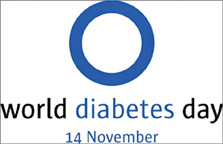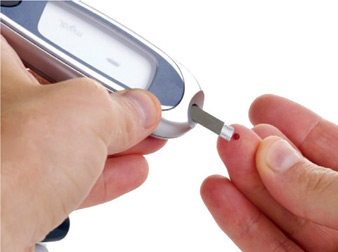|
 World Diabetes Day on November 14: World Diabetes Day on November 14:
A right start with healthy living
By Carol Aloysius
World Diabetes Day will be observed on November 14. Led by the
International Diabetes Foundation (IDF, this special UN designated day
has for the past several years, focussed on bringing together the global
diabetic and pre-diabetic community to take responsibility for making
that extra effort at controlling and preventing this life threatening
disease, that claims millions of lives every day, every hour, every
minute.
The message given them is simple: Adopt healthy eating habits and
make lifestyle changes by giving up on habits such as eating starchy,
sugary foods heavy on oil and fat, stop smoking and drinking and
exercise regularly. In short, live healthily.
This is the message chosen as the theme on World Diabetes Day this
year with several countries across the world organising programs
highlighting the theme of ‘Off to a right start with Healthy Living’
this year. The same theme incidentally will continue to be used for
World Diabetes Day next year as well, states the IDF which is an
umbrella organisation of over 230 national diabetic associations in 110
countries.
Considering the rising level of diabetes worldwide, the decision to
come together to fight diabetes on a global scale, is both timely and
very much the need of the hour as the following statistics from a
several countries reveal.
|

Avoid eating starchy, sugary foods heavy on oil and fat |
In the US latest statistics reveal a staggering 210 million people
live with diabetes and almost 1/3 are not even aware they have it.
According to a report by the Australian Institute of Health and
Welfare 2007-8 approximately 274,200 people lived with diabetes in New
South Wales (NSW), 184,700 in Victoria and 154,000 in Queensland which
is now considered the ‘ diabetic capital’ in Australia, with young
children most at risk.
* In Canada, over nine million Canadians are said to be currently
living with diabetes or are pre-diabetic.
* In Sri Lanka, diabetes prevalence is said to have zoomed over the
past two decades. According to recent studies, 1:5 adults have
prediabetes or diabetes and 1/3 diabetic patients are walking around
without even knowing it as they are still to be diagnosed. The same
studies indicated that age/sex standardised diabetes prevalence in those
over 20 years was 10.3 percent higher.
WHO in its report of 2006 states that in Sri Lanka, mortality due to
diabetes has increased in the past two decades. Studies by the Ministry
of Healthcare and Nutrition 2002 underlines this when it states hospital
admissions due to diabetes and complications of the diseases showed a
parallel rise from 86 to 226 per ‘100,000 population over the past two
decades.
Prevention
Based on Registrar General Department figures, in 2001, analysis of
age standardised data from 1999-2001 has shown that chronic non
communicable diseases including diabetes, accounted for 71 percent of
all deaths in Sri Lanka.
It is because of the rapidly increasing number of people who have
diabetes but are unaware of this fact, that many countries including Sri
Lanka are now launching awareness raising programs with free screening
tests. In the US for example, on Tuesday November 14, along with these
programs organisers will offer healthy diets and recipes to anyone
interested.
Awareness
So how is diabetes day observed in Sri Lanka?
According to officials at the Ministry of Healthcare and Nutrition, a
walk has been organised for young and old in Colombo while regional
directors of health also organise their own programs to raise awareness.
Seminars, discussions, printed booklets, posters and CDs will also be
distributed at clinics, while screening programs will be conducted for
possible symptoms of diabetes in most government hospitals including the
National Hospital, Colombo.
What causes diabetes in the first place?
An endocrinologist explains: Diabetes Mellitus is a condition with
high blood sugar caused by a reduction of insulin activity. Insulin is a
vital hormone produced by the pancreas and helps sugar/glucose to enter
the cells where it is used as fuel to produce energy. Reduced insulin
activity is due to absolute deficiency or decreased insulin activity due
to insulin resistance.
Who is at risk?
Anyone; however, he adds, the risk factors for Type 1 diabetes though
not well defined appear to be triggered by genetic and environment
factors.
On the other hand the risk factors for Type 2 diabetes are quite
clearly defined.
They include:
Non Modifiable risk factors such as age, family history of diabetes
and race/ethnicity - where certain races show greater tendency to
develop diabetes.
Modifiable factors include abnormal appetite. Here both under and
over nutrition plays a major role in developing T2DM, he explains.
Under-nutrition occurs mainly in the womb leading to increased insular
resistance and together with over nutrition after birth, leads to
obesity and Type 2 diabetes in early life, even in children (juvenile
diabetes).
The third risk factor is physical inactivity which he stresses is the
most significant factor. “Hence physical exercise in adequate amounts on
a regular basis is a MUST”, he said.
In the case of Pre-diabetics, he says, impaired fasting glycaemia (IFG)
or Impaired Glucose Tolerance (IGT) are risks and should be corrected
with proper nutrition, exercise and stress control.
 Diabetes in pregnancy (Gestational Diabetes) is also common and on
the increase and a risk to mother and child in later life. “This is why
maternity hospitals in our country are now setting up special units to
screen, monitor and control pregnant women who arrive, some of them
without even knowing they have the disease,” he said. Diabetes in pregnancy (Gestational Diabetes) is also common and on
the increase and a risk to mother and child in later life. “This is why
maternity hospitals in our country are now setting up special units to
screen, monitor and control pregnant women who arrive, some of them
without even knowing they have the disease,” he said.
Services
Today, the National Hospital and Lady Ridgeway Hospital for Children
run special diabetic units where obese children and children with a
potential to develop diabetes as well as those who are already showing
signs of the disease are being treated, and advised along with their
parents.
In the case of elderly patients too, the General Hospital has a
special diabetic centre where experts in the field screen and monitor
each patient and gives them free drugs. At Sri Jayewardenapura Hospital
diabetes is managed through a special clinic run on the lines of the
guidelines by the latest American Diabetes Association.
We also have the Diabetes Association of Sri Lanka, a non-profit
organisation which serves the diabetic fraternity through primary and
secondary prevention, education, awareness and advocacy.
It is also heartening to note that several private health facilities
will set up fully equipped diabetes centres with state of the art
services.
Ministry spokesman told, “Diabetes is currently one of the biggest
burdens on the national budget. It is also a disease that afflicts many
persons who could otherwise contribute to the economy of the country.
The key is preventing it. Diabetes starts from the womb when the mother
eats an unhealthy diet at pregnancy.
The only way to prevent it is by leading a healthy life- style”. |

